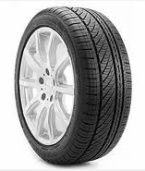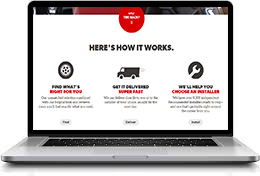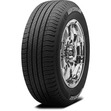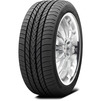
Proper Tire Inflation
Tires should not be inflated to the pressure on the sidewall; this is the maximum pressure, rather than the recommended pressure. For passenger vehicles and light trucks, the tires should be inflated to what the vehicle manufacturer recommends, which is usually located just inside the driver's door or in the vehicle owners handbook.
With low tire pressure, the tire will absorb more bumps from driving, and with this constant bending of the side wall as it absorbs the contours of the road, it can overheat the tire. It can also result in cuts or blow-out. When tire pressure is too low, the tire's contact patch is also changed. This decreases rolling resistance, tire flexing, and friction between the road and tire.
Having tire pressure that is too high can have its downsides: the sacrifice in comfort and the increased chance of obtaining a puncture when driving over sharp objects.
Tires with correct inflation are more inclined to keep their shape during any encounter, and will thus transmit the forces of the road to the suspension, rather than being damaged itself. This allows for an increased reaction speed, and "feel" of the road. It has also been found that correct tire pressure results in shorter stopping distances.
Tires should not be inflated to the pressure on the sidewall; this is the maximum pressure, rather than the recommended pressure. For passenger vehicles and light trucks, the tires should be inflated to what the vehicle manufacturer recommends, which is usually located just inside the driver's door or in the vehicle owners handbook.
With low tire pressure, the tire will absorb more bumps from driving, and with this constant bending of the side wall as it absorbs the contours of the road, it can overheat the tire. It can also result in cuts or blow-out. When tire pressure is too low, the tire's contact patch is also changed. This decreases rolling resistance, tire flexing, and friction between the road and tire.
Having tire pressure that is too high can have its downsides: the sacrifice in comfort and the increased chance of obtaining a puncture when driving over sharp objects.
Tires with correct inflation are more inclined to keep their shape during any encounter, and will thus transmit the forces of the road to the suspension, rather than being damaged itself. This allows for an increased reaction speed, and "feel" of the road. It has also been found that correct tire pressure results in shorter stopping distances.
|
When it comes to air, tires lose pressure over time so it is important to check them regularly. The U.S. Department of Energy estimates that you can increase your gas mileage around 3% by keeping your tires inflated properly.
|
Related Articles
|
Tire Videos
1. Snow tires, all-season tires, and summer tires comparison on ice. 2. How often do you really need to rotate your tires? |
Best Low Rolling Resistance Tires
You can save gas money with the right tires. But which ones save the most and how do they perform? |
Michelin Defender
Is this the best value Touring All Season tire available on the market today? |
All Season Performance Tires
Excellent response and handling in wet and dry conditions, as well as light snow.
Excellent response and handling in wet and dry conditions, as well as light snow.
Performance Summer Tires
Low profile tires provide great handling and traction for both dry and wet conditions
Low profile tires provide great handling and traction for both dry and wet conditions






